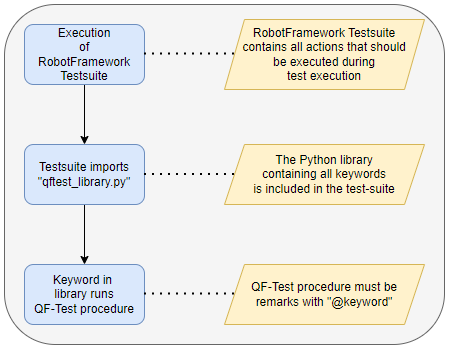
When automating the execution of test cases, Scheidt & Bachmann has been using the test tool QF-Test for several years already, as it is ideally suited for testing Java GUI applications.
Now, the challenge was to use the already existing Java GUI test cases including all procedures created in QF-Test also within Robot Framework. This was necessary because Robot Framework is the tool of choice for testing field devices running on the Linux operating system with the Qt application under test.
In order to create complete end-to-end test cases between field device (Qt application) and back office application (Java application), we needed a way to connect QF Test with Robot Framework. Here we quickly came across the interface offered by QF-Test, which allows Robot Framework to address and execute individual procedures via keyword (Robot Framework uses the approach of keyword-driven testing).
The following figure shows how Robot Framework uses and controls a QF-Test procedure:
This approach allowed us to create complete end-to-end test cases that greatly simplify and speed up the execution of release tests at field device and back office level.
A significant impact during the implementation of this new feature had the very cooperative and fast customer support of QFS, which allowed us to make noticeable progress in a very short time.
In the future, this approach will save us a lot of time in creating new automated test cases, as well as in executing them.
Author: Marvin Klerx
QS - Fare Collection
Scheidt & Bachmann Fare Collection Systems GmbH
Mönchengladbach, Germany
